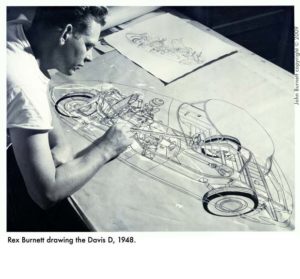

As part of the 2018 10th Anniversary of the Gualala Arts Auto Show and Pinewood Derby, we are proud to once again bring this excellent exhibit of Rex Burnett drawings to the Burnett Gallery for the enjoyment of artists and auto enthusiasts alike. Rex was a long-time Sea Ranch resident and Gualala Arts patron. In the postwar forties he worked as a technical illustrator in the aircraft industry even as he participated in the birth of the classic Hot Rod® magazine and started drawing for the publication.
The exhibit will feature his cutaway drawings done without the benefit of computers and 3-D CAD programs. These pieces have attracted attention from not only hot rod buffs but also from the art world. One of his most famous drawings is the Pierson Brothers Coupe. Ten years ago, the Behring Auto Museum at Blackhawk featured a one-man show of his work.
Rex Burnett grew up in Boston, Arkansas, and started drawing at a very young age, filling his school books with car sketches. He liked to examine the tire tracks left in the dusty road by the occasional automobile passing through his small midwest town and as a teenager he studied the automotive ads in The Saturday Evening Post® and Colliers® magazines. He was also intrigued by the futuristic cars in Esquire® magazine by designer Count Alexis de Sakhnoffsky, but it was the startling beauty of the innovative 1936 Cord 810 that elevated its legendary designer, Gordon M. Buehrig, to near sainthood for the young Burnett.
In college, Burnett studied engineering with a minor in art. He was interrupted by service in the Navy during WWII; his formal art education was limited to a still-life drawing class.
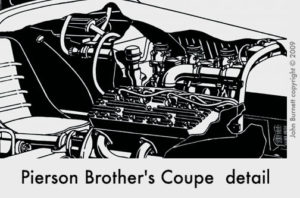
After the war, he worked as a technical artist for Douglas Aircraft where he created complex illustrations for aircraft catalogs, manuals, and proposals. He was soon introduced to Gary Davis, future creator of the Davis Divan, a three-wheeled car. Davis needed someone to imagine and draw a body style for the Divan. He hired Burnett to do the job and the drawing was published in Hot Rod Magazine® in 1948. After that, while still working full-time in the aerospace industry, Burnett made regular contributions to “The Hot Rod of the Month” and later created art for Motor Trend® , Auto® , and Cycle® magazines.
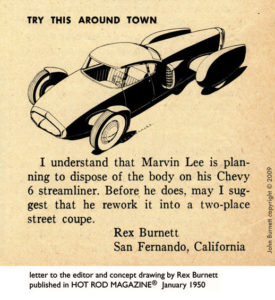 The source materials for Burnett’s automotive drawings were usually a small stack of black-and-white photographs of an automobile’s components shot separately in pieces, prior to the car’s assembly. Burnett used the photographs as reference materials to “assemble” his cars as a pencil drawing on tracing paper. Over this pencil drawing he would lay down a sheet of vellum upon which he used a technical pen to make the final ink drawing.
The source materials for Burnett’s automotive drawings were usually a small stack of black-and-white photographs of an automobile’s components shot separately in pieces, prior to the car’s assembly. Burnett used the photographs as reference materials to “assemble” his cars as a pencil drawing on tracing paper. Over this pencil drawing he would lay down a sheet of vellum upon which he used a technical pen to make the final ink drawing.

Also on display will be automobilia from Carl “The Hooligan” Olson. Olson was a leader in the drag racing segment of the auto racing industry for decades, including a stint as National Hot Rod Association vice president for international relations.
In 1946, at the tender age of 3, Olson attended his first oval track event. Olson first drove a fuel dragster in 1964, but his greatest success on the strip came when he joined up with Mike Kuhl and by 1972 he was IHRA Top Fuel World Champion and a regular Top Fuel Dragster winner at NHRA events.
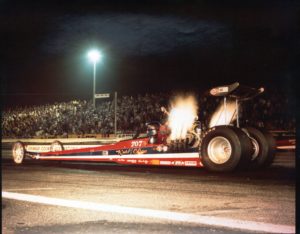
He won the last Top Fuel dragster eliminator to be held at Lions. By 1976 he had finished his racing career and took a Vice President’s role with the NHRA. His many years in the racing industry have earned him innumerable honors and trophies. Olson was owner and driver of The Hooligan dragster (pictured), which is how he earned his nickname.
Olson was the IHRA Top Fuel World Champion in 1972 and received the NHRA Lifetime Achievement Award in 2007. Olson was inducted into the British Drag Racing Hall of Fame in 2012.
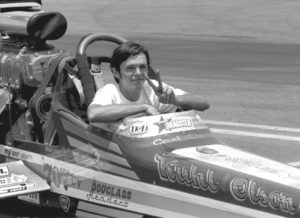
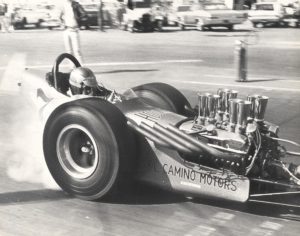
Fremont Drag Strip, California in 1965.
To find out more about the 10th Anniversary Gualala Arts Auto Show, go here.
 Gualala Arts Promoting public interest and participation in the arts since 1961
Gualala Arts Promoting public interest and participation in the arts since 1961